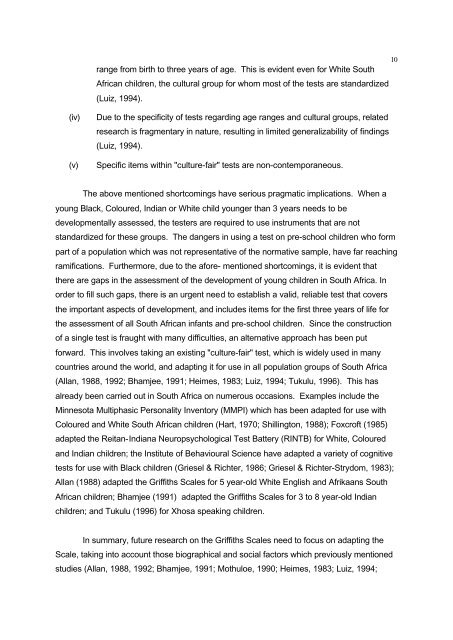nicole kotras masters thesis
nicole kotras masters thesis
nicole kotras masters thesis
Create successful ePaper yourself
Turn your PDF publications into a flip-book with our unique Google optimized e-Paper software.
ange from birth to three years of age. This is evident even for White South<br />
African children, the cultural group for whom most of the tests are standardized<br />
(Luiz, 1994).<br />
(iv) Due to the specificity of tests regarding age ranges and cultural groups, related<br />
research is fragmentary in nature, resulting in limited generalizability of findings<br />
(Luiz, 1994).<br />
(v) Specific items within "culture-fair" tests are non-contemporaneous.<br />
The above mentioned shortcomings have serious pragmatic implications. When a<br />
young Black, Coloured, Indian or White child younger than 3 years needs to be<br />
developmentally assessed, the testers are required to use instruments that are not<br />
standardized for these groups. The dangers in using a test on pre-school children who form<br />
part of a population which was not representative of the normative sample, have far reaching<br />
ramifications. Furthermore, due to the afore- mentioned shortcomings, it is evident that<br />
there are gaps in the assessment of the development of young children in South Africa. In<br />
order to fill such gaps, there is an urgent need to establish a valid, reliable test that covers<br />
the important aspects of development, and includes items for the first three years of life for<br />
the assessment of all South African infants and pre-school children. Since the construction<br />
of a single test is fraught with many difficulties, an alternative approach has been put<br />
forward. This involves taking an existing "culture-fair" test, which is widely used in many<br />
countries around the world, and adapting it for use in all population groups of South Africa<br />
(Allan, 1988, 1992; Bhamjee, 1991; Heimes, 1983; Luiz, 1994; Tukulu, 1996). This has<br />
already been carried out in South Africa on numerous occasions. Examples include the<br />
Minnesota Multiphasic Personality Inventory (MMPI) which has been adapted for use with<br />
Coloured and White South African children (Hart, 1970; Shillington, 1988); Foxcroft (1985)<br />
adapted the Reitan-Indiana Neuropsychological Test Battery (RINTB) for White, Coloured<br />
and Indian children; the Institute of Behavioural Science have adapted a variety of cognitive<br />
tests for use with Black children (Griesel & Richter, 1986; Griesel & Richter-Strydom, 1983);<br />
Allan (1988) adapted the Griffiths Scales for 5 year-old White English and Afrikaans South<br />
African children; Bhamjee (1991) adapted the Griffiths Scales for 3 to 8 year-old Indian<br />
children; and Tukulu (1996) for Xhosa speaking children.<br />
In summary, future research on the Griffiths Scales need to focus on adapting the<br />
Scale, taking into account those biographical and social factors which previously mentioned<br />
studies (Allan, 1988, 1992; Bhamjee, 1991; Mothuloe, 1990; Heimes, 1983; Luiz, 1994;<br />
10
















